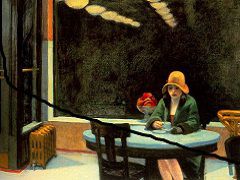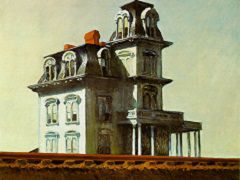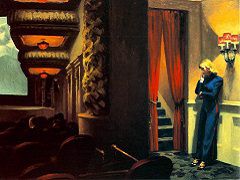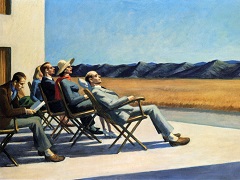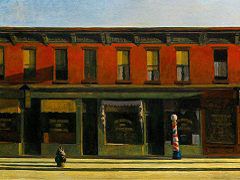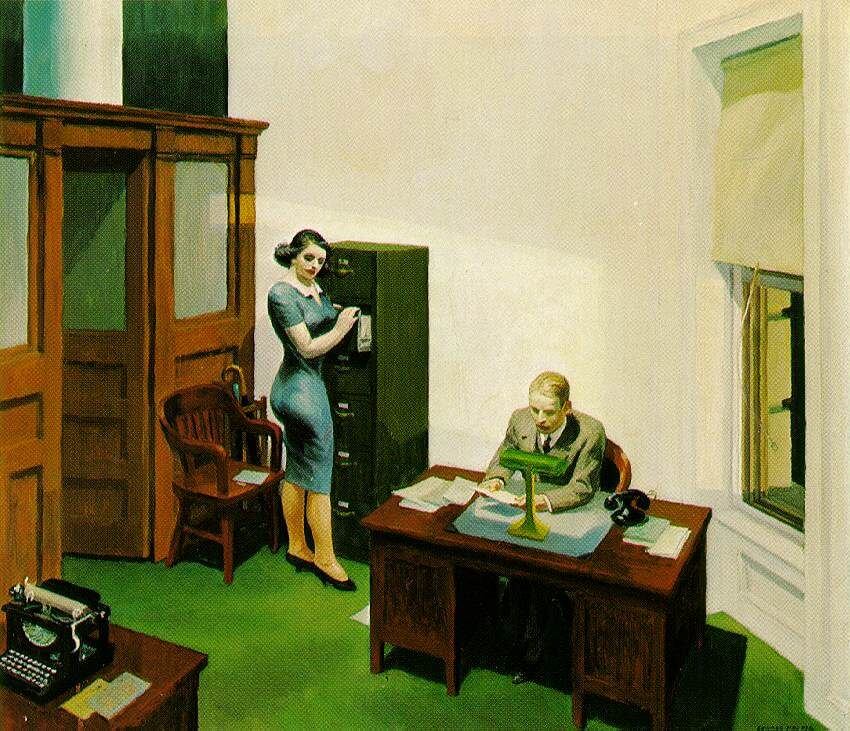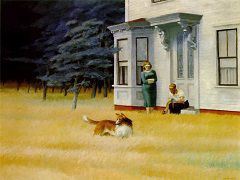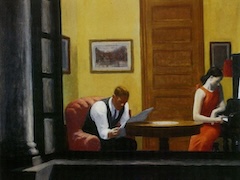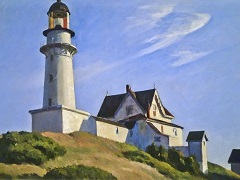New York Restaurant, 1922 by Edward Hopper

A first look at Hopper's work reveals the important role that light plays in evoking the atmosphere characteristic of his paintings. Natural and artificial light create a borderland of either clarity or oppressive density. Some of
Hopper's paintings from the twenties show how his depiction of light defines the human situation.
In New York Restaurant, Automat, and Chop Suey, human subjects are portrayed in social situations like an evening at the theater or a restaurant, although none of
these pictures tells an actual story. Where the people come from, where they are going, what they are looking at, is peripheral. What primarily interests Hopper is creating a specific atmosphere, transcending the momentary,
in which man is viewed comprehensively.
Hopper referred to this intention in a comment on New York Restaurant: "In a specific and concrete sense the idea was to attempt to make visual the crowded glamour of a New York restaurant during the noon hour. I am hoping that
ideas less easy to define have, perhaps, crept in also." It is obvious that his special use of light is important for expressing what is "less easy to define," namely, the way in which light isolates the human figure in a room,
and how light and shadow formations become an independent element, thereby giving the interior new shape and meaning. The viewer's eye is led to these zones of light, which are independent of the human figures and objects.
The dynamics of the human encounter are lost in this kind of light. The figures are engulfed in a strangely dense atmosphere that impedes their movements and forces them to look into themselves, away from the person facing them,
away from the outside world in general.New York Restaurant, for example, is a tranquil painting in which time stands still and the everyday scene has been transformed. Cbop Suey, the last painting from the
nineteen-twenties, clearly shows the direction Hopper's art was to take. This painting is a formal construction of lines and flat surfaces in which color and especially light-fields take on an optical reality of their own,
independent of the concrete objects depicted.
The predominance of formal values corresponds to the speechlessness and motionlessness of the figures. Furthermore, it becomes clear that this play of light imbues the objects with special importance in contrast to the human
subjects. The pot and bowl on the table, each a visual unit together with its shadows, are meant to be not objects used by man but primarily a combination of form and color, thereby assuming an independent existence. This
autonomy is also evident in the neon sign outside and the coat hanging to the left. Since both of these objects are traversed by a field of light, their status as independent objects is particularly striking. What we observe here
is a living exchange between objects and light, taking place without man's awareness. The objects can, of course, be recognized and classified according to their everyday function, but at the same time they are portrayed as
formal, abstract entities and thus take on an independence apart from their usefulness. For an understanding of Hopper's work, it is essential to recognize the autonomy the objects have assumed.


